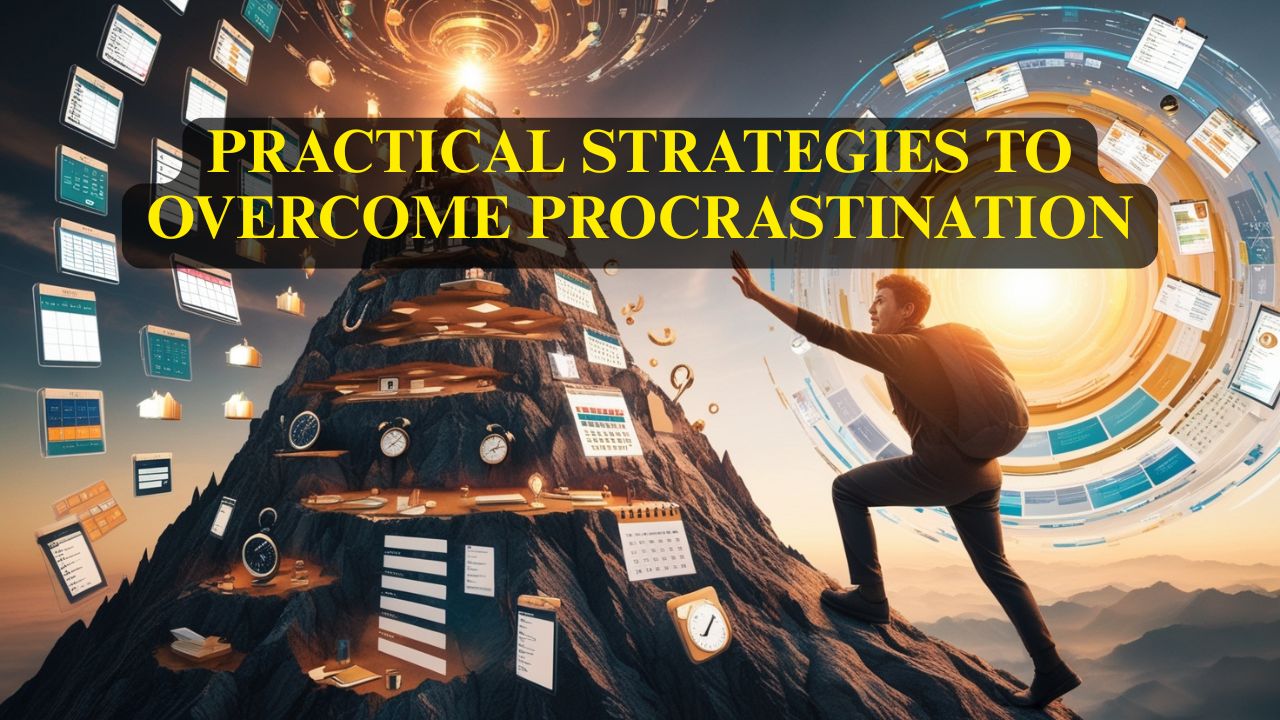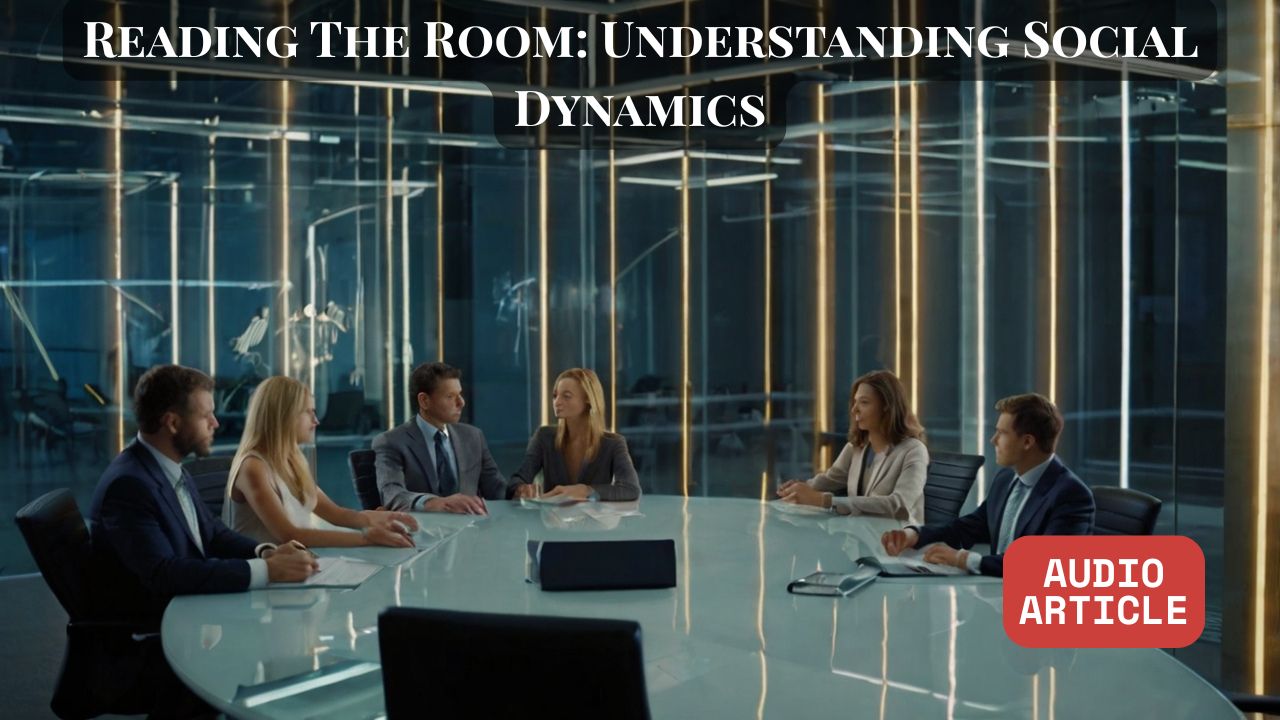Reading the Room: Understanding Social Dynamics
You walk into a meeting and immediately sense something's off. People are sitting differently than usual, conversations stop a beat too long when you enter, and there's a tension in the air you could cut with a knife. Nobody says anything directly, but you can feel that something significant happened before you arrived.
Or maybe you're at a dinner party, telling what you think is a funny story, when you notice the subtle shift in the room. Smiles become a bit more forced, someone changes the subject quickly, and you realize you've somehow missed the mark, though you're not sure how.
These moments highlight one of the most valuable yet under-taught skills in human interaction: the ability to read the room. It's about picking up on the unspoken communication that's always happening beneath the surface of social interactions - the invisible currents that actually drive most of what happens between people.
Some people seem to have this ability naturally, effortlessly navigating social situations and always knowing exactly what to say or do. But reading the room isn't magic or an inborn talent - it's a learnable skill that can dramatically improve your relationships, your career, and your overall social confidence.
How to Pick Up on Unspoken Communication
Most of human communication happens without words. Researchers estimate that only about 7% of communication is verbal, while 38% is vocal tone and 55% is body language and other nonverbal cues. This means that if you're only listening to the words people say, you're missing 93% of what's actually being communicated.
But here's the challenge: we're not taught to pay attention to nonverbal communication. We learn to focus on words, facts, and explicit information while ignoring the rich emotional and social data that's constantly available to us.
The Baseline Principle The first step in reading nonverbal communication is understanding people's baseline behavior - how they normally act when they're comfortable and relaxed. Everyone has their own natural patterns of body language, vocal tone, and energy level. You can only detect changes when you know what's normal for that person.
Your colleague might naturally be quiet and reserved, so their subdued energy in a meeting isn't a sign of discomfort - it's just their baseline. But if your normally outgoing friend is suddenly quiet and withdrawn, that's meaningful information about their emotional state.
Pay attention to how people typically behave in different contexts. How do they sit in meetings? What's their normal energy level during casual conversations? How do they usually respond to humor or serious topics? Building this baseline understanding helps you notice when something shifts.
Clusters, Not Single Signals One isolated gesture or expression doesn't tell you much. Someone might cross their arms because they're cold, not because they're defensive. A person might avoid eye contact because they're thinking, not because they're lying or uncomfortable.
Instead, look for clusters of signals that point in the same direction. If someone crosses their arms, leans back, avoids eye contact, and speaks in shorter sentences than usual, that cluster suggests they might be feeling defensive or withdrawn. Multiple signals that align give you much more reliable information than any single behavior.
Incongruence Between Words and Body Language Pay special attention when someone's words don't match their nonverbal communication. If someone says "I'm fine" while their shoulders are tense, their voice is tight, and they're avoiding eye contact, their body is telling you something different than their words.
This incongruence often indicates that the person is experiencing emotions they're not ready or able to express directly. They might not even be fully aware of what they're feeling, but their body is communicating it anyway.
Energy and Emotional Contagion Humans are remarkably sensitive to each other's emotional states. We unconsciously mirror the emotions of people around us, which is why you can walk into a room and immediately feel whether the atmosphere is tense, excited, sad, or celebratory.
This emotional contagion happens through micro-expressions, body posture, vocal tone, and even breathing patterns that we pick up on unconsciously. Learning to tune into these subtle energy shifts gives you valuable information about the emotional climate of any social situation.
Timing and Rhythm Notice the timing and rhythm of conversations. Are people speaking over each other or leaving long pauses? Are responses coming quickly or slowly? Is there a natural flow to the interaction or does it feel forced?
Changes in conversational rhythm often signal shifts in comfort level, interest, or emotional state. A conversation that suddenly becomes stilted might indicate someone said something that created discomfort, even if nobody explicitly acknowledged it.
The Invisible Rules That Govern Group Behavior
Every social group - whether it's a family, workplace team, friend group, or professional organization - operates according to unwritten rules that everyone is expected to understand and follow. These rules are rarely discussed openly, but violating them can have significant social consequences.
Power Dynamics and Hierarchy Most groups have informal power structures that may or may not match the official hierarchy. Understanding who has real influence, who defers to whom, and how decisions actually get made helps you navigate the group more effectively.
Watch how people position themselves physically in relation to others. Who speaks first in meetings? Whose opinions carry the most weight? Who do people look to when difficult questions arise? These patterns reveal the actual power dynamics, which might be quite different from what the organizational chart suggests.
Also notice how communication flows in the group. In some cultures and organizations, you're expected to share your thoughts directly. In others, it's more appropriate to speak privately with key influencers before bringing up ideas in group settings.
Topics That Are Safe vs. Off-Limits Every group has subjects that are welcome for discussion and others that are taboo or sensitive. These boundaries aren't usually announced - you have to pick up on them through observation and experience.
Watch how people respond when different topics come up. Does energy in the room shift when certain subjects are mentioned? Do people change the subject quickly? Do conversations become more formal or more guarded?
Learning these invisible boundaries helps you contribute meaningfully to conversations without accidentally stepping on landmines that could damage your relationships or credibility.
Communication Styles and Preferences Groups develop their own communication norms around directness, formality, humor, and emotional expression. Some groups value straight talk and direct feedback. Others prefer more diplomatic, indirect approaches. Some welcome humor and casual banter, while others maintain a more serious, professional tone.
Matching your communication style to the group's preferences doesn't mean being fake or losing your authenticity. It means being socially intelligent about how to express your authentic self in ways that resonate with the people around you.
Decision-Making Processes Understanding how decisions actually get made in a group is crucial for being effective. Some groups make decisions through open discussion and consensus. Others have one or two key decision-makers who listen to input but ultimately decide alone. Still others make decisions through informal conversations and lobbying before formal meetings.
Watch how decisions unfold over time. Where do the real conversations happen? Who needs to be convinced for something to move forward? What kind of information or arguments tend to be persuasive with this particular group?
When to Speak Up and When to Listen
One of the most important aspects of reading the room is knowing when your input will be welcome and valuable versus when you should observe and listen. This skill can make the difference between being seen as insightful and helpful versus pushy and tone-deaf.
Reading Receptivity Before sharing your thoughts, gauge whether people are in a receptive state. Are they leaning forward and making eye contact, or are they checking phones and looking distracted? Is the energy level high and engaged, or low and tired?
If people seem overwhelmed, stressed, or emotionally charged, they may not be in the best state to consider new information or perspectives. Sometimes the most valuable thing you can do is simply listen and provide emotional support rather than trying to problem-solve or share advice.
Understanding Your Role In different situations, you'll have different roles and levels of appropriate participation. Sometimes you're there as a subject matter expert expected to share your knowledge. Other times you're there to learn and should ask more questions than you give answers.
Consider your relationship to the group and the topic at hand. Are you new to the organization or situation? Are you senior or junior to the other participants? Are you there in a formal role or as a casual participant? Matching your level of participation to your role and relationships shows social intelligence.
Timing and Context Even when you have valuable input, timing matters enormously. The same comment that would be brilliant at one moment might fall flat or create problems at another time.
Wait for natural openings in the conversation rather than interrupting or forcing your way in. Pay attention to the energy and focus of the group. If everyone is deeply engaged in exploring one topic, introducing a completely different subject might be disruptive, even if your point is valid.
Adding Value vs. Filling Silence Learn to distinguish between speaking because you have something genuinely valuable to contribute versus speaking because you feel uncomfortable with silence or want to appear engaged.
Comfortable silence is often a sign of a group that's thinking deeply or processing information. Rushing to fill every pause can actually detract from the quality of the conversation. Some of the most powerful contributions come from people who speak less frequently but make their words count when they do speak.
Amplifying Others vs. Taking Center Stage Sometimes the most valuable contribution you can make is amplifying someone else's good idea or helping a quieter person be heard, rather than promoting your own thoughts.
Watch for situations where someone shares a valuable insight that doesn't get the attention it deserves, or where a less assertive person tries to contribute but gets talked over. Saying something like "I think Sarah made a really important point about..." or "Can we go back to what John was saying about..." can be incredibly valuable for both the individual and the group.
Navigating Different Social Contexts
The same person might need to read the room very differently in various social contexts. What works in one setting can be completely inappropriate in another, even with some of the same people involved.
Professional vs. Personal Settings The boundaries, communication styles, and expectations in professional settings are usually quite different from personal ones. People may be more formal, guarded, or focused on specific outcomes at work, while being more relaxed and emotionally expressive in personal settings.
Don't assume that because you know someone well personally, you understand how they operate professionally, or vice versa. Many people have distinctly different personas in different contexts, and respecting these boundaries is important for maintaining good relationships across settings.
High-Stakes vs. Low-Stakes Situations The emotional temperature and social dynamics change dramatically based on what's at stake. A casual brainstorming session has a very different feel from a meeting where layoffs are being discussed, even if the same people are in both meetings.
In high-stakes situations, people are often more careful with their words, more sensitive to criticism, and more focused on protecting their interests. Humor that would be welcome in low-stakes settings might be inappropriate when people are stressed or worried about serious consequences.
Cultural and Generational Differences Different cultural backgrounds and generational cohorts have different norms around communication, authority, personal space, eye contact, and many other social behaviors. What feels respectful and appropriate in one cultural context might feel distant or even rude in another.
Rather than assuming everyone shares your cultural norms, pay attention to how people from different backgrounds interact with each other and adjust your approach accordingly. When in doubt, err on the side of being more formal and respectful until you understand the specific norms of the group.
Group Size and Intimacy Social dynamics change significantly based on group size. One-on-one conversations allow for more personal sharing and direct communication. Small groups of three to five people can have intimate discussions but also require more careful attention to ensuring everyone feels included.
Large groups often become more formal and require different strategies for participation. It's harder to read individual reactions, easier for some people to hide their true feelings, and more important to be concise and clear when you do speak.
Developing Your Social Radar
Like any skill, reading the room improves with conscious practice and attention. Here are some strategies for developing your social awareness:
The Observer Exercise In your next few social interactions, spend the first few minutes primarily observing rather than participating. Notice body language, energy levels, communication patterns, and group dynamics before jumping into the conversation.
What do you notice about how people are positioned in relation to each other? Who seems comfortable and who seems tense? What topics generate enthusiasm versus discomfort? This conscious observation helps train your awareness.
The Check-In Practice Periodically throughout conversations, do quick internal check-ins: "How is this landing with people?" "What's the energy level right now?" "Is this the right time for what I want to say?"
These brief pauses for awareness can prevent you from missing important social cues or continuing down a conversational path that isn't working for the group.
The Post-Interaction Review After important social interactions, take a few minutes to reflect on what you observed. What went well? What felt off? What social cues did you notice, and how did you respond to them?
This reflection helps you learn from each interaction and gradually become more skilled at reading social situations in real time.
Asking for Feedback With people you trust, occasionally ask for feedback about your social awareness: "How did I do in that meeting?" "Was there anything I missed about how people were responding to the presentation?" "Do you think I read the situation accurately?"
This kind of feedback can reveal blind spots and help you calibrate your social radar more accurately.
When You Misread the Room
Everyone misreads social situations sometimes, even people who are generally socially skilled. The key is learning how to recover gracefully and what to do when you realize you've missed important social cues.
Recognizing the Signs Sometimes you'll realize in the moment that you've misread the situation - maybe your joke falls flat, your suggestion creates awkward silence, or you notice people exchanging glances. Other times, you might not realize until later that you missed something important.
Learning to recognize these moments quickly allows you to adjust your approach before doing further damage to the interaction or relationship.
The Graceful Recovery When you realize you've misread the room, the best approach is usually to acknowledge it simply and move on. You might say something like "I think I misread the situation there" or "Let me try that again" or simply "Sorry, that didn't come out right."
Don't over-apologize or make a big deal out of the mistake. Most people appreciate the awareness and self-correction, and dwelling on it often makes things more awkward than the original mistake did.
Learning from Mistakes Use social mistakes as learning opportunities rather than reasons for self-criticism. What cues did you miss? What might you do differently in a similar situation? How can you be more attuned to similar dynamics in the future?
The people who become most socially skilled aren't those who never make mistakes - they're the ones who learn most effectively from the mistakes they do make.
The Limits of Reading the Room
While social awareness is incredibly valuable, it's important to understand its limitations. Not everything that happens in social situations is about you or under your control.
People Have Bad Days Sometimes someone's mood or behavior has nothing to do with the current situation or your actions. They might be dealing with personal problems, health issues, work stress, or family challenges that affect how they show up socially.
While it's important to be aware of and responsive to people's emotional states, don't assume that you caused every negative emotion you observe or that you're responsible for fixing every social tension you notice.
Cultural and Individual Differences People from different cultural backgrounds may express emotions, show respect, handle conflict, and navigate relationships in ways that are unfamiliar to you. What seems like disinterest might be cultural respect for authority. What feels like rudeness might be cultural directness.
Similarly, individual personality differences mean that some people are naturally more expressive while others are more reserved. Don't assume that quiet means disengaged or that animated means enthusiastic without considering individual and cultural baselines.
Your Own Filters and Projections Your own emotional state, past experiences, and current concerns affect how you interpret social situations. If you're feeling insecure, you might interpret neutral expressions as disapproval. If you're excited about something, you might see enthusiasm where others see polite tolerance.
Developing social awareness includes becoming aware of your own filters and biases that might distort your reading of situations.
Building Genuine Connection
The ultimate goal of reading the room isn't to manipulate social situations for your own benefit - it's to connect more authentically and helpfully with the people around you. Social awareness should serve relationship building, not self-serving agenda advancement.
Empathy in Action Reading social cues allows you to respond to people's actual needs rather than just your own assumptions about what they need. If you notice someone seems overwhelmed, you might offer practical help or simply listen rather than adding more information to their plate.
This kind of empathetic responsiveness builds trust and deepens relationships because people feel seen and understood by you.
Creating Safe Spaces When you're attuned to social dynamics, you can help create environments where everyone feels comfortable participating. You might notice when someone is trying to speak but can't get a word in, or when a topic is making people uncomfortable, or when the group energy needs a shift.
Using your social awareness to support others rather than just yourself makes you someone people want to be around and trust with important conversations.
Authentic Expression Within Social Context Reading the room doesn't mean becoming a social chameleon who has no authentic self. It means learning how to express your authentic thoughts, feelings, and personality in ways that work well within different social contexts.
You can be genuinely yourself while also being socially intelligent about timing, approach, and context. In fact, this combination of authenticity and social awareness often makes people more compelling and trustworthy, not less.
Remember: Social Skills Are Learnable
If reading the room doesn't come naturally to you, don't despair. Social intelligence can be developed through conscious attention and practice, just like any other skill. Some people have natural advantages, but everyone can improve their ability to understand and navigate social dynamics.
Start by paying more attention to the nonverbal communication happening around you. Notice patterns in how different people and groups operate. Practice adjusting your communication style to match the context and audience.
Most importantly, remember that the goal is connection, not perfection. People generally appreciate effort and genuine care more than flawless social performance. When you show that you're paying attention to others and trying to contribute positively to social interactions, most people will respond warmly, even if your execution isn't perfect.
Your relationships, career, and overall social confidence will improve as you develop this crucial but often overlooked skill. Reading the room is about tuning into the human experience happening all around you and responding with wisdom, empathy, and social intelligence.






